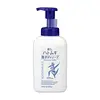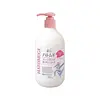What's inside
What's inside
 Key Ingredients
Key Ingredients

 Benefits
Benefits

 Concerns
Concerns

 Ingredients Side-by-side
Ingredients Side-by-side

Water
Skin ConditioningLauric Acid
CleansingMyristic Acid
CleansingPotassium Hydroxide
BufferingCocamide Mea
EmulsifyingGlycerin
HumectantGlycol Distearate
EmollientCocamidopropyl Betaine
CleansingSodium Laureth Sulfate
CleansingCocamide DEA
EmulsifyingSodium Chloride
MaskingPotassium Cocoyl Glutamate
Sodium Cocoyl Glutamate
CleansingSodium Lauroyl Methylalanine
Sh-Barley Seed Extract
Skin ConditioningButyrospermum Parkii Butter
Skin ConditioningSodium Hyaluronate
HumectantButylene Glycol
HumectantPropylene Glycol
HumectantPolyquaternium-7
Alcohol Denat.
AntimicrobialTetrasodium EDTA
Phenoxyethanol
PreservativeEthylparaben
PreservativeParfum
MaskingWater, Lauric Acid, Myristic Acid, Potassium Hydroxide, Cocamide Mea, Glycerin, Glycol Distearate, Cocamidopropyl Betaine, Sodium Laureth Sulfate, Cocamide DEA, Sodium Chloride, Potassium Cocoyl Glutamate, Sodium Cocoyl Glutamate, Sodium Lauroyl Methylalanine, Sh-Barley Seed Extract, Butyrospermum Parkii Butter, Sodium Hyaluronate, Butylene Glycol, Propylene Glycol, Polyquaternium-7, Alcohol Denat., Tetrasodium EDTA, Phenoxyethanol, Ethylparaben, Parfum
Water
Skin ConditioningParaffinum Liquidum
EmollientGlycerin
HumectantButylene Glycol
HumectantTitanium Dioxide
Cosmetic ColorantCarbomer
Emulsion StabilisingAcrylates/C10-30 Alkyl Acrylate Crosspolymer
Emulsion StabilisingSqualane
EmollientHydrolyzed Jojoba Seed Extract
Ceramide Ng
Skin ConditioningSodium Hyaluronate
HumectantSoluble Collagen
HumectantSimmondsia Chinensis Seed Oil
EmollientArgania Spinosa Kernel Oil
EmollientPotassium Hydroxide
BufferingSilica
AbrasiveMica
Cosmetic ColorantXanthan Gum
EmulsifyingTetrasodium EDTA
Sodium Hydroxide
BufferingPhenoxyethanol
PreservativeMethylparaben
PreservativeEthylparaben
PreservativeHc Red No. 10
CI 15985
Cosmetic ColorantWater, Paraffinum Liquidum, Glycerin, Butylene Glycol, Titanium Dioxide, Carbomer, Acrylates/C10-30 Alkyl Acrylate Crosspolymer, Squalane, Hydrolyzed Jojoba Seed Extract, Ceramide Ng, Sodium Hyaluronate, Soluble Collagen, Simmondsia Chinensis Seed Oil, Argania Spinosa Kernel Oil, Potassium Hydroxide, Silica, Mica, Xanthan Gum, Tetrasodium EDTA, Sodium Hydroxide, Phenoxyethanol, Methylparaben, Ethylparaben, Hc Red No. 10, CI 15985
Ingredients Explained
These ingredients are found in both products.
Ingredients higher up in an ingredient list are typically present in a larger amount.
Butylene Glycol (or BG) is used within cosmetic products for a few different reasons:
Overall, Butylene Glycol is a safe and well-rounded ingredient that works well with other ingredients.
Though this ingredient works well with most skin types, some people with sensitive skin may experience a reaction such as allergic rashes, closed comedones, or itchiness.
Learn more about Butylene GlycolEthylparaben is a preservative, is a paraben, and is not reef safe.
Glycerin is already naturally found in your skin. It helps moisturize and protect your skin.
A study from 2016 found glycerin to be more effective as a humectant than AHAs and hyaluronic acid.
As a humectant, it helps the skin stay hydrated by pulling moisture to your skin. The low molecular weight of glycerin allows it to pull moisture into the deeper layers of your skin.
Hydrated skin improves your skin barrier; Your skin barrier helps protect against irritants and bacteria.
Glycerin has also been found to have antimicrobial and antiviral properties. Due to these properties, glycerin is often used in wound and burn treatments.
In cosmetics, glycerin is usually derived from plants such as soybean or palm. However, it can also be sourced from animals, such as tallow or animal fat.
This ingredient is organic, colorless, odorless, and non-toxic.
Glycerin is the name for this ingredient in American English. British English uses Glycerol/Glycerine.
Learn more about GlycerinPhenoxyethanol is a preservative that has germicide, antimicrobial, and aromatic properties. Studies show that phenoxyethanol can prevent microbial growth. By itself, it has a scent that is similar to that of a rose.
It's often used in formulations along with Caprylyl Glycol to preserve the shelf life of products.
Potassium hydroxide is commonly known as caustic potash. It is used to fix the pH of a product or as a cleaning agent in soap. In cleansers, it is used for the saponification of oils.
Sapnification is the process of creating fatty acid metal salts from triglycerides and a strong base. During this process, Potassium Hydroxide is used up and is not present in the final product.
Using high concentrations of Potassium Hydroxide have shown to irritate the skin.
Learn more about Potassium HydroxideSodium Hyaluronate is hyaluronic acid's salt form. It is commonly derived from the sodium salt of hyaluronic acid.
Like hyaluronic acid, it is great at holding water and acts as a humectant. This makes it a great skin hydrating ingredient.
Sodium Hyaluronate is naturally occurring in our bodies and is mostly found in eye fluid and joints.
These are some other common types of Hyaluronic Acid:
Learn more about Sodium HyaluronateTetrasodium EDTA is the salt formed from neutralizing ethylenediamine tetraacetic acid with sodium hydroxide. It is a chelating agent and used to prevent metal ions from binding to other ingredients. This helps keep the product and ingredients stable.
Tetrasodium EDTA comes as a white solid and is soluble in water.
Water. It's the most common cosmetic ingredient of all. You'll usually see it at the top of ingredient lists, meaning that it makes up the largest part of the product.
So why is it so popular? Water most often acts as a solvent - this means that it helps dissolve other ingredients into the formulation.
You'll also recognize water as that liquid we all need to stay alive. If you see this, drink a glass of water. Stay hydrated!
Learn more about Water